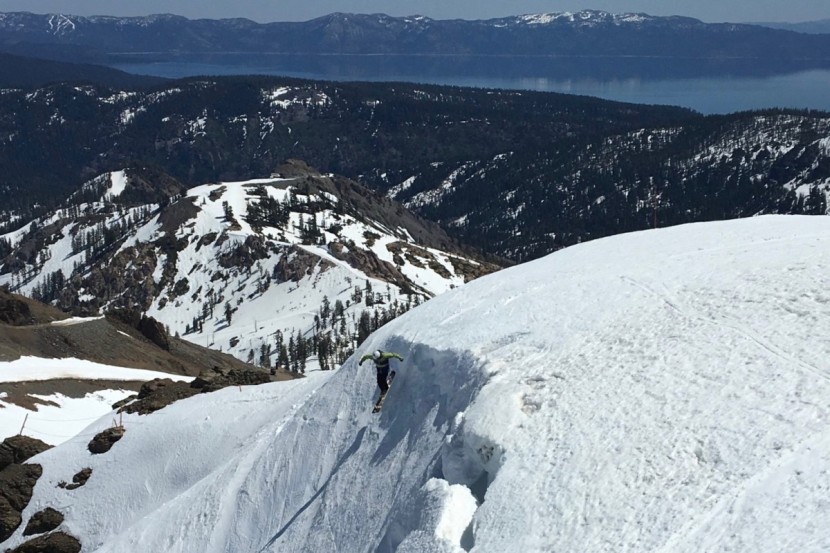- Lab Impact Testing – One of each model in our review is sent to ACT Lab for impact testing. We have worked closely with ACT to develop impact tests that go beyond industry standards. Details of this process are outlined below.
- Extensive Field Testing — We also send our team to the slopes with a helmet that is identical to each model we send to the lab. Our testers go to great lengths to ski and snowboard with these helmets as much as they can in every weather condition they encounter. They ripped it up in the frigid cold, warm spring-like days, sideways snowstorms, and even in the pouring rain. Our main testing areas were located in the resorts and backcountry of the Lake Tahoe region and Northwest Montana.
Impact Test
In cooperation with the lab specialists, we created a set of tests that go beyond ASTM and CEN standards. Our reason for going the extra mile is that all of these helmets have met industry-standard safety qualifications, but the certification is a pass/fail. Here at GearLab, it is our goal to gather objective data so that we can rank products and provide the most detailed information that we can to our readers.
ACT uses a dummy head outfitted with accelerometer sensors to measure the g-force a person might experience in a crash. We have them conduct impact tests from two different impact speeds – in one test, the head dummy is dropped from a 1-meter height, and in the other tests, it is dropped from a 2.3-meter height. The lower height is designed to mimic lower or slower shocks to the helmet, while the higher height is designed to replicate a big, serious hit. Since helmets use different materials and tactics to mitigate impacts at slower speeds vs. faster speed impacts, we believe it is essential to conduct two distinct tests so we can measure each helmet's performance during both types of impact.
We then take the data we receive from the lab and calculate a score of 1-10 for both “fast” and “slow” impacts, then average the two for an overall Impact Test score.
Comfort
Ski helmets must keep your head comfortable while skiing, sitting on the lift, and even walking around the resort. We rated helmet comfort based on the snugness of fit and general feeling while skiing. We noted if there were any pressure points, including on the earmuffs. We also made a point to notice how each of the chin straps felt. The more easily a product is adjusted to fit our heads via dials and sliding mechanisms, the better it scored here.
Warmth
Ski helmets need to perform in various temperatures - from frigid Arctic air to warm spring days. Everybody runs at a slightly different temperature, but a warm ski helmet should generally negate the need to wear a hat underneath. To determine how warm these helmets really were, we skied during freezing days throughout our testing period to see if the helmet could maintain its heat in the coldest temperatures.
Ventilation
An excellent ski helmet has a well-crafted ventilation system that can easily open and close to remove excess heat. To compare the helmets, we first counted how many vents were on each helmet. Then we used both gloves and mittens to see how easily the vents were to open and close. Finally, we skied a fast run with the vents open and one with them closed to see how much air passed through the helmet.
Usability
For this metric, we examine the various aspects of each model that don't pertain to impact testing, ventilation, comfort, or warmth but can make a huge difference in your overall experience while wearing a helmet.
Weight
When we considered the weight of each ski helmet, we first noted how heavy they were when carrying them in packs while climbing up for backcountry skiing. In the end, the scale gave the final say. From there, the score for weight was based on those considerations.
Goggle Compatibility
Ski helmets don't always fit with every pair of goggles. It is essential to make sure the helmet you choose does not create a “gaper gap” or create downward pressure problems on your goggles. We considered the design of the goggle strap fasteners as well. When we were testing these helmets, we tried them on with several pairs of goggles to make sure all types of frame designs could make a tight seal with the helmet. As we skied, we noted if the helmet created any pressure problems, how well they stayed in place, and if we could feel the wind on our forehead due to any gaps.
Style
Style is subjective but does play a role in ski helmet choice and even functionality. While in the lift line and on the skin track, we asked many skiers and snowboarders what they thought of the style of each helmet. This survey created a consensus score and helped to limit personal bias.







